Ross 128 is a faint red dwarf star located in the zodiac constellation Virgo. Lying only 11.007 light-years away, it is the 14th individual closest star to the Sun. It hosts an Earth-sized planet, Ross 128 b, which orbits in the star’s inner habitable zone. Shining at magnitude 11.13, the star is invisible to the unaided eye.
Star type
Ross 128 is a red dwarf of the spectral type M4V. It has 16.8% of the Sun’s mass and 19.67% of the solar radius. With an effective temperature of 3,192 K, it shines with 36% of the Sun’s luminosity. Most of the star’s energy output is in the infrared band. The red dwarf radiates only about 0.033% of the Sun’s visible luminosity.
The star has an estimated age of 9.45 billion years, more than twice that of the Sun. It has iron levels similar to our star.
Ross 128 is classified as a flare star and has the variable star designation FI Virginis. Flare stars occasionally show dramatic increases in brightness due to flares that last for only a few minutes. Many nearby red dwarfs belong to this class, including Proxima Centauri, Barnard’s Star, Wolf 359, Lalande 21185, and the red dwarf pair BL Ceti and UV Ceti.
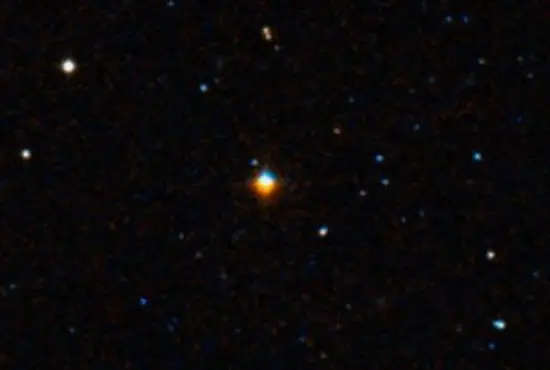
Ross 128, image: Wikisky
Ross 128 exhibits a low rate of flare activity and is believed to be a magnetically evolved star. A stellar flare from the star was detected on May 12, 1972. The brightness change was barely detected in the optical band, but the star brightened by about half a magnitude in the ultraviolet band (U band). The brightness change lasted less than an hour and then the star returned to its normal brightness. It was subsequently classified as a flare star.
Smaller brightness variations of just a few thousands of a magnitude have also been detected. They are thought to be caused by magnetic cycles and rotation. Ross 128 takes 165.1 days to complete a rotation and has a magnetic cycle of 4.1 years.
In 2018, a team led by Diogo Souto at Observatório Nacional in Rio de Janeiro, Brazil, and Johanna Teske of Carnegie Observatories in California published the first detailed chemical abundances of Ross 128. The analysis was based on spectra obtained with APOGEE (Apache Point Observatory Galactic Evolution Experiment), a program in the Sloan Digital Sky Survey III (SDSS-III) that conducted a systematic survey of Milky Way stars. The researchers relied on the ability of APOGEE to measure the near-infrared light of Ross 128 and derive abundances of carbon, oxygen, aluminum, magnesium, calcium, potassium, iron, and titanium. They found that the star has near solar metallicity.
Ross 128 hosts an Earth-sized exoplanet, Ross 128 b, that orbits in the inner edge of the star’s habitable zone.
Ross 128 b
Ross 128 b is a planet a bit larger and more massive than Earth. It orbits the host star at a distance of 0.0496 astronomical units (7.42 million kilometres). The planet’s orbit is about 20 times closer than Earth’s around the Sun. Ross 128 b is believed to have a circular orbit with an eccentricity of only about 0.03. It has a rotation period of only 9.9 days.
The planet is likely rocky and one of the best candidates for habitability in the solar neighbourhood. It gets only 38% more starlight than Earth and its equilibrium temperature – estimated to be between -60 and 20°C – likely allows for the presence of liquid water on the surface. Provided, of course, that the planet has an atmosphere.
Ross 128 b orbits close to its parent star and is probably tidally locked, i.e. has the same side always facing the star. This would mean that one side of the planet is always in darkness, while the other always has daylight.
Ross 128 b is the second nearest Earth-size planet to the Sun, after Proxima b. Like Ross 128 b, Proxima b orbits in the habitable zone of its host star (Proxima Centauri).
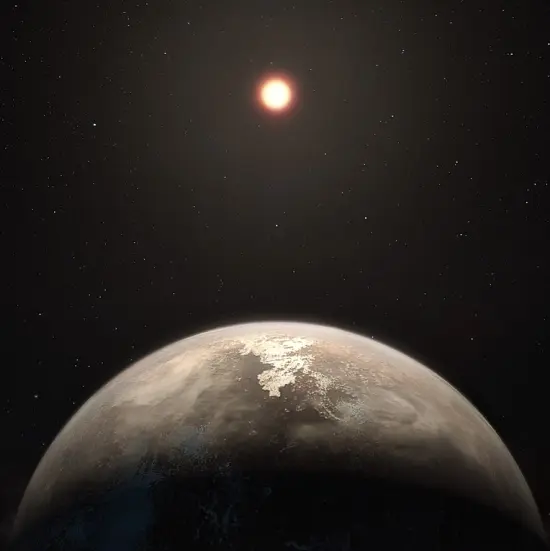
This artist’s impression shows the temperate planet Ross 128 b, with its red dwarf parent star in the background. This planet, which lies only 11 light-years from Earth, was found by a team using ESO’s unique planet-hunting HARPS instrument. The new world is now the second-closest temperate planet to be detected after Proxima b. It is also the closest planet to be discovered orbiting an inactive red dwarf star, which may increase the likelihood that this planet could potentially sustain life. Image credit: ESO/M. Kornmesser (CC BY 4.0)
Ross 128 b was discovered by Xavier Bonfils of the Institute of Planetology and Astrophysics of Grenoble, France, in July 2017. The planet’s existence was confirmed on November 15, 2017. The planet was detected using radial velocity data collected with the European Southern Observatory’s HARPS spectrograph at the La Silla Observatory in Chile over the course of a decade.
Ross 128 b has a mass of about 1.8 Earth masses (1.37 – 2.36 M⊕) and a radius of about 1.6 Earth radii (0.95 – 2.7 R⊕). Astronomers believe that it probably contains iron and rock, based on the analysis of near-infrared high-resolution spectra obtained with the Sloan Digital Sky Survey’s APOGEE spectroscopic instrument. APOGEE data showed that the star Ross 128 has a similar metallicity to the Sun. Scientists used the data to create various models and these indicated that Ross 128b is a temperate planet orbiting in the inner edge of the host star’s habitable zone.
The silicon level could not be measured in the host star, but the ratio of iron to magnesium suggests that the planet likely has a larger core compared to Earth. Astronomers could not measure the planet’s radius directly. Instead, they estimated a range based on the planet’s minimum mass and stellar abundances. The radius estimate suggests that the planet should be rocky.
The team also measured the temperature of Ross 128 and, taking into account the estimated radius, determined how much of the star’s light is reflected on the surface of Ross 128 b. They concluded that the planet likely has a temperate climate, assuming it formed with the same composition as its parent star. Even though it is not an Earth twin, it could potentially sustain liquid water on its surface.
Facts
Ross 128 orbits near the Milky Way’s plane and is an old disk star. The old disk (or thick disk) in the Sun’s neigbourhood consists of mostly older stars. Like Ross 128, these stars have lower levels of metals, i.e. elements other than hydrogen and helium.
Ross 128 orbits through the Milky Way with an eccentricity that takes it within 26,800 light-years of the Galactic centre and as far away as 34,200 light-years. The orbit will gradually take the star closer to the solar system. In about 71,000 years, Ross 128 will make its closest approach to the Sun, coming within only 6.233 light-years.
Observations with the Spitzer Space Telescope in the 2000s found that Ross 128 does not have an infrared excess. An infrared excess would indicate the presence of a dust ring orbiting a star. Dust in these circumstellar disks is maintained by collisions between asteroid-sized objects and its characteristics reflect the planet-building processes in a stellar system.
In the spring of 2017, astronomers at the Arecibo Observatory in Puerto Rico reported unusual radio signals transmitted at a frequency they had not detected before in a red dwarf. The strange signal appeared to be coming from Ross 128. Dr. Abel Méndez, a planetary astrobiologist at the University of Puerto Rico at Arecibo, described it as “broadband quasi-periodic non-polarized pulses with very strong dispersion-like features.”
The transmission was detected on May 12 and lasted about 10 minutes. Scientists speculated that this could be a new type of stellar flare or a product of interaction between the star and an orbiting planet. At the time, no planets had been detected around the star. The Breakthrough Listen team observed the star but found no evidence of the transmission. The signal turned out to be the product of transmissions from Earth satellites in geosynchronous orbit (orbit that matches Earth’s rotation).
Name
Ross 128 does not have a formal name. The designation Ross 128 comes from a 1926 catalogue compiled by American astronomer Frank Elmore Ross. Ross succeeded Edward Emerson Barnard at Yerkes Observatory in Williams Bay, Wisconsin. He studied Barnard’s collection of photographic plates and discovered more than a thousand high-proper motion stars, including Ross 128, and 379 new variable stars. His catalogue of high-proper motion stars was published in The Astronomical Journal in 1926.
Some of the stars with high proper motion turned out to lie in the Sun’s neighbourhood and are still widely referred to by their number in Ross’s catalogue. Ross 154 and Ross 248, two red dwarfs slightly closer to the Sun than Ross 128, are among them.
Ross 128 is also known by its variable star designation FI Virginis. It is catalogued as Gliese 447 (GJ 447) in the Gliese Catalogue of Nearby Stars.
Location
Ross 128 is challenging to find because at magnitude 11.13 it is not visible to the unaided eye. It appears about halfway from Regulus, the brightest star in Leo, to Spica, the luminary of Virgo. It can be found just south-southwest of Zavijava (Beta Virginis), one of the stars that form the Y of Virgo.
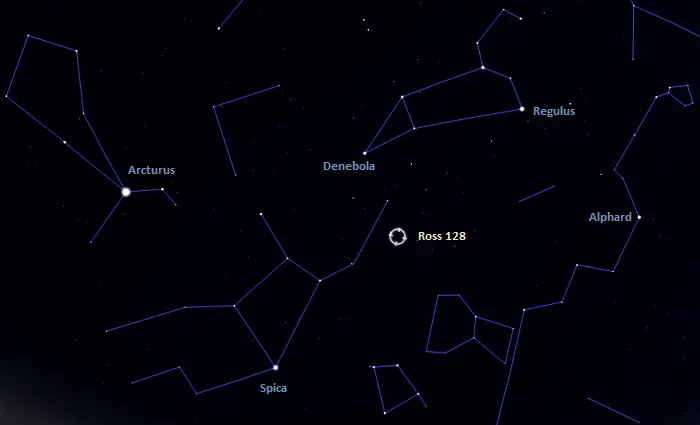
The location of Ross 128, image: Stellarium
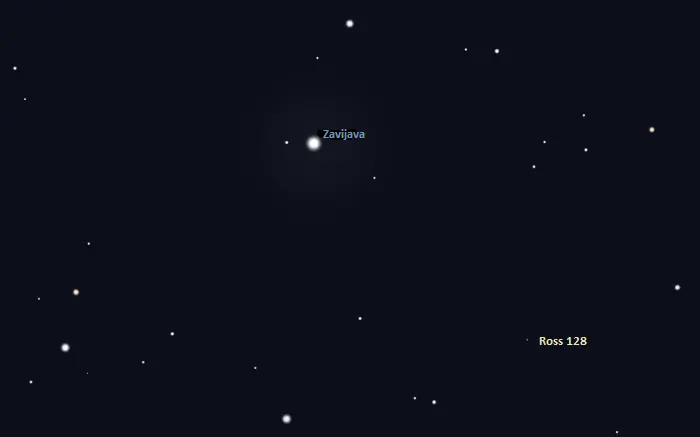
Ross 128 location, image: Stellarium
Constellation
Ross 128 is located in the constellation Virgo. Virgo is one of the 15 equatorial constellations, visible from most places for at least part of the year. It is the second largest constellation in the sky – smaller only than Hydra – occupying 1,294 square degrees of the sky. First catalogued by the Greco-Roman astronomer Ptolemy in his Almagest in the 2nd century CE, it is one of the Greek constellations, known to observers since ancient times.
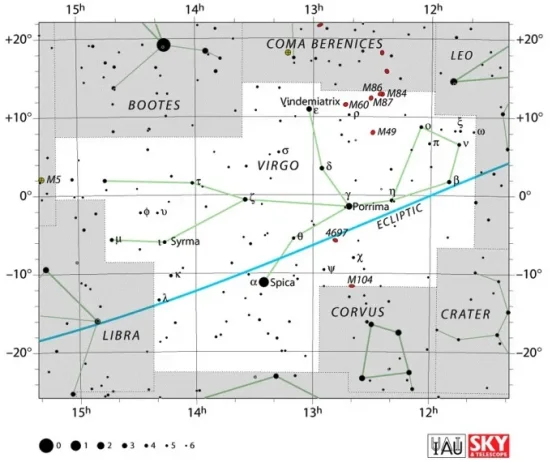
Virgo constellation map by IAU and Sky&Telescope magazine
Virgo is home to Spica (Alpha Virginis), the 16th brightest star in the sky. It is recognizable for the large crooked Y asterism that extends from Spica in the direction of the neighbouring zodiac constellation Leo.
Other notable stars in Virgo include the giants Delta and Kappa Virginis, formally known as Minelauva and Kang, and the yellow dwarf 61 Virginis, which hosts three exoplanets.
Virgo is known for being home to more Messier objects than any other constellation except Sagittarius. Most of these objects are galaxies in the Virgo Cluster. They include the elliptical galaxies Messier 49, Messier 87, and Messier 60, the spirals Messier 58, Messier 61, and Messier 90, and the lenticular galaxies Messier 84 and Messier 86. The constellation also hosts the Sombrero Galaxy (Messier 104), a famous edge-on spiral galaxy that resides outside the Virgo Cluster, and the elliptical galaxy IC 1101, one of the largest galaxies ever discovered.
The best time of the year to see the stars and deep sky objects in Virgo is during the month of May, when the constellation rises high above the horizon in the evening sky. The entire constellation is visible from locations between the latitudes 80° N and 80° S.
The 10 brightest stars in Virgo are Spica (Alpha Vir, mag. 0.97), Porrima (Gamma Vir, mag. 2.74), Vindemiatrix (Epsilon Vir, mag. 2.826), Heze (Zeta Vir, mag. 3.376), Minelauva (Delta Vir, mag. 3.39), Zavijava (Beta Vir, mag. 3.604), 109 Virginis (mag. 3.72), Mu Virginis (mag. 3.88), Zaniah (Eta Vir, mag. 3.89), and Nu Virginis (mag. 4.04).
Ross 128
| Spectral class | M4V or dM4 |
| Variable type | Flare star |
| U-B colour index | +2.685 |
| B-V colour index | +1.59 |
| Apparent magnitude | 11.13 |
| Absolute magnitude | 13.53 |
| Distance | 11.007 ± 0.001 light-years (3.3749 ± 0.0003 parsecs) |
| Parallax | 296.3053 ± 0.0302 mas |
| Radial velocity | -30.66 ± 0.0005 km/s |
| Proper motion | RA: 607.299 ± 0.034 mas/yr |
| Dec.: -1223.028 ± 0.023 mas/yr | |
| Mass | 0.168 ± 0.017 M☉ |
| Luminosity | 0.00362 ± 0.00039 L☉ |
| Radius | 0.1967 ± 0.0077 R☉ |
| Temperature | 3,192 ± 60 K |
| Metallicity | −0.02 ± 0.08 dex |
| Age | 9.45 ± 0.60 billion years |
| Rotation | 165.1 days |
| Surface gravity | 3.40 cgs |
| Constellation | Virgo |
| Right ascension | 11h 47m 44.3972681420s |
| Declination | +00° 48′ 16.400337591″ |
| Names and designations | Ross 128, FI Virginis, HIP 57548, GJ 447, GCTP 2730, LHS 315, GCRV 7139, PLX 2730.00, G 010-050, Vyssotsky 286, LTT 13240, NLTT 28570, LFT 852, LSPM J1147+0048, IRAS 11451+0105, 2MASS J11474440+0048164, TYC 272-1051-1, Gaia DR1 3796072587910775936, Gaia DR2 3796072592206250624, Gaia DR3 3796072592206250624 |